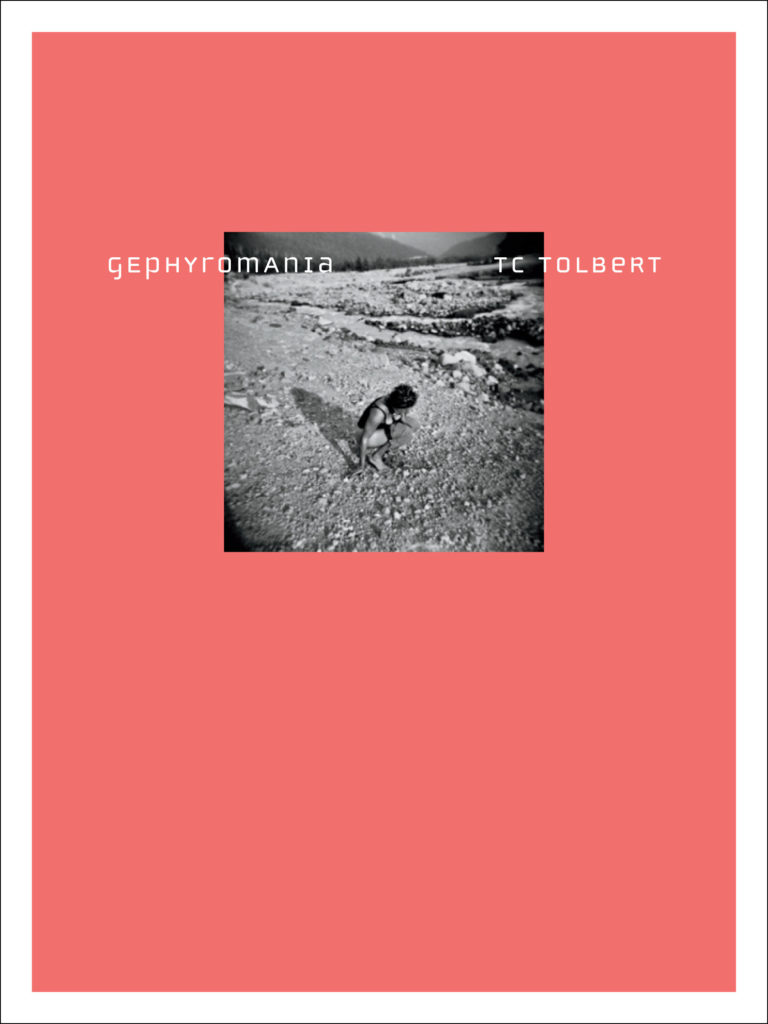Gephyromania
T.C. Tolbert
96 pages, paperback
ISBN 978-1-934103-52-4
Ahsahta Press, 2014
The first and last sections of Tolbert’s book are meant to be read horizontally, thus furthering the idea of latitude and bridges, which stretch our minds in new directions and our vision beyond what’s visible on the page. The experience of reading in this “unconventional” way points to the fixedness that we assume regarding texts and our world. Here, Tolbert explains what it’s like “having lived through the funnel both ways”; what is means “to stand between the text and its articulation.” S/he confirms what is means to fully live and thrive within these in-between constructs of language and gender — and without a need to arrive at one end of the spectrum.
In the two line poem, Elegy, Tolbert addresses his/her former self: “I am so not myself (sometimes) I look at her./And we are never equal to the breaking that we bring.” Like so many images in the text, this breaking contains multiple meanings: the breaking that we impose upon ourselves in order to survive, the breaking of others’ hearts, and the breaking down of the barriers and constructs that keep us from fully living our truths. Tolbert breaks away and releases one gender, but gains another. S/he addresses the self that is still present in traces of body and memory: “She is prologue. And simultaneous. She is domicile.” Can we ever fully erase a past self? Tolbert mines the past to remind us all that “We are a bedrock of antecedents.” And, later, splashed near the middle of the horizontal page: [&sing. &sing./&sing.]”. Negative space surrounds these sparse lines, holding their seemingly disparate threads together and leaving room for the reader to contemplate their own “bedrock of antecedents.” They also provide an area in which to celebrate the self (in Whitmanesque fashion) that we are now.
It’s not surprising that Tolbert continually references the body, especially the mouth. The line, “what the mouth covers, and in covering, introduces” appears at the beginning and end of the book, serving as a bookend to highlight what’s hidden and unsaid, as the text becomes “a topiary digressing in the mouth.” Words are spoken, taken in, digested, then spit out and rearranged: “thin is tongue wing-ed, not not birds.” In the process, the body erodes and reconfigures as the speaker undergoes transitions from one gender to another “by the way the break abandons the troubled mouth.”
Tolbert affirms his/her body as the text. S/he circles back to images of the body (the presence and absence of breasts) and utterances, but also highlights the “failure of repetition.” We cannot go back to the selves we were, as the body is in an impermanent state, in flux. The self in transition can carry itself beyond its histories and assert: “that the body, which is my body is a relevancy.”

Heather Sweeney is an MFA candidate and Allen Ginsberg Fellow at the Jack Kerouac School of Disembodied Poetics at Naropa University. Her poetry and book reviews have been published in Dusie, Cutbank, Shampoo, canwehaveourballback? Summerstock and Galatea Resurrects. When she is not in Boulder, she lives in San Diego with her husband and beloved dog, Dexter.
